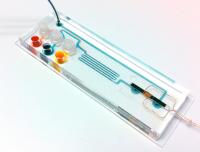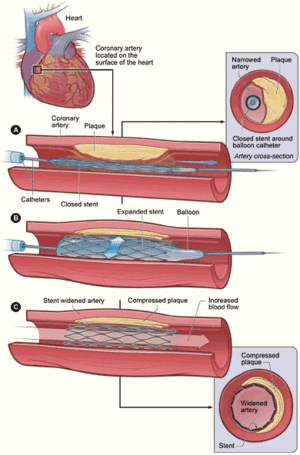
“These described methods allow us to do this in two to three hours, a vast improvement over standard culturing practice, which can take as much as two weeks to provide a diagnosis.”
A handheld diagnostic device that Massachusetts General Hospital (MGH) investigators first developed to diagnose cancer has been adapted to rapidly diagnose tuberculosis (TB) and other important infectious bacteria. Two papers appearing in the journals Nature Communications and Nature Nanotechnology describe portable devices that combine microfluidic technology with nuclear magnetic resonance (NMR) to not only diagnose these important infections but also determine the presence of antibiotic-resistant bacterial strains.
“Rapidly identifying the pathogen responsible for an infection and testing for the presence of resistance are critical not only for diagnosis but also for deciding which antibiotics to give a patient,” says Ralph Weissleder, MD, PhD, director of the MGH Center for Systems Biology (CSB) and co-senior author of both papers. “These described methods allow us to do this in two to three hours, a vast improvement over standard culturing practice, which can take as much as two weeks to provide a diagnosis.”
Investigators at the MGH CSB previously developed portable devices capable of detecting cancer biomarkers in the blood or in very small tissue samples. Target cells or molecules are first labeled with magnetic nanoparticles, and the sample is then passed through a micro NMR system capable of detecting and quantifying levels of the target. But initial efforts to adapt the system to bacterial diagnosis had trouble finding antibodies – the detection method used in the earlier studies – that would accurately detect the specific bacteria. Instead the team switched to targeting specific nucleic acid sequences.
The system described in the Nature Communications paper, published on April 23, detects DNA from the tuberculosis bacteria in small sputum samples. After DNA is extracted from the sample, any of the target sequence that is present is amplified using a standard procedure, then captured by polymer beads containing complementary nucleic acid sequences and labeled with magnetic nanoparticles with sequences that bind to other portions of the target DNA. The miniature NMR coil incorporated into the device – which is about the size of a standard laboratory slide – detects any TB bacterial DNA present in the sample.
Tests of the device on samples from patients known to have TB and from healthy controls identified all positive samples with no false positives in less than three hours. Existing diagnostic procedures can take weeks to provide results and can miss up to 40 percent of infected patients. Results were even stronger for patients infected with both TB and HIV – probably because infection with both pathogens leads to high levels of the TB bacteria – and specialized nucleic acid probes developed by the research team were able to distinguish treatment-resistant bacterial strains.
The Latest Bing News on:
Handheld diagnostic device
- Owlstone secures $6.5M for breath-based diagnostics for infectious diseaseon April 26, 2024 at 5:40 am
Owlstone Medical has secured a $5 million equity investment and initial $1.5 million grant funding, committed by the Bill and Melinda Gates Foundation, for development of breath-based diagnostic ...
- Exo adds FDA-cleared AI tools to handheld ultrasound systemon April 25, 2024 at 8:50 am
Exo sees the new capabilities as especially helpful for healthcare providers in rural and under-resourced settings.
- ADMT: Advancements in Medical Device Innovationon April 24, 2024 at 1:05 am
ADM Tronics remains focused on research and development, producing therapeutic and diagnostic medical devices across various fields including audiology, physical medicine, wound therapy, neurology, ...
- Ultrasound Devices Market is Set to Surpass Valuation of USD 11,229.9 Million By 2032: Astute Analyticaon April 23, 2024 at 5:30 am
The global ultrasound devices market surges, driven by rising chronic diseases, technological advancements in portability and imaging, and an aging population demanding accessible diagnostics. Growth ...
- ThinkSono Releases Real-Time DVT AI Training Solution for Butterfly Network's Handheld Ultrasound Deviceson April 23, 2024 at 12:08 am
Medical Schools, healthcare providers and individual clinicians can now leverage state-of-the-art AI algorithms, which seamlessly connect with Butterfly's handheld ultrasound devices, revolutionizing ...
- We tried the best cordless vacuums of 2024 — here are our top pickson April 22, 2024 at 11:12 am
I’ve discovered that utilizing a cordless vacuum is the optimal approach to evade frustration with a lack of outlets. It gives you a wide range without getting tangled up in cords. When my husband and ...
- Android 15 could tell you how long your phone's storage will survive foron April 19, 2024 at 9:24 am
When you purchase through links on our site, we may earn an affiliate commission. Here’s how it works.
- FDA approves Lumicell’s fluorescent system for highlighting residual breast cancer tissueon April 19, 2024 at 8:08 am
The FDA has granted a groundbreaking approval to a fluorescent light system that illuminates leftover breast cancer tissue in real-time during surgery—to help ensure a thorough removal of the tumor | ...
- Obituaries PGe PG Store Archives Classifiedson April 18, 2024 at 2:30 am
The instrument, known as i-STAT Alinity, builds on another Dr. Okonkwo-researched tool: The i-STAT TBI, approved by the FDA in 2021, was the first handheld, rapid and objective blood test for ...
- Abbott's gains in medical device sales push quarterly haul to nearly $10Bon April 17, 2024 at 8:37 am
Abbott saw large gains in its medical device sales that helped push its revenues to just shy of $10 billion—exceeding the company’s expectations and leading it to nudge up its financia | Abbott’s ...
The Latest Google Headlines on:
Handheld diagnostic device
[google_news title=”” keyword=”handheld diagnostic device” num_posts=”10″ blurb_length=”0″ show_thumb=”left”]
The Latest Bing News on:
Diagnostic device
- Google Ads Diagnostic Tool Low Keyword Quality Warningon April 26, 2024 at 4:11 am
Google Ads is showing yet another new and fun notice to some advertisers. This one shows an impression issue for "Low keyword quality." As a reminder, as for diagnostic insights, quality score is not ...
- Buy Rating Affirmed on Promising CHK1 Inhibitor and Diagnostic Synergyon April 25, 2024 at 11:18 pm
Leerink Partners analyst Andrew Berens has maintained their bullish stance on BOLD stock, giving a Buy rating on April 22. Andrew Berens has ...
- North Texas-Based StatLab Acquires Chicago’s Scientific Device Laboratoryon April 25, 2024 at 3:39 pm
StatLab said its acquisition of SDL expands customer reach for both entities and provides a new U.S. research and development hub for the broader StatLab organization.
- Diagnostics pioneer Bonnie Anderson launches PinkDx to focus on women's healthon April 25, 2024 at 8:12 am
Bonnie Anderson jumps back into diagnostics, leading women's health-focused company launching with $40 million ...
- Examples of Patents for Computer-Aided Diagnostic Methodson April 24, 2024 at 5:00 pm
Additionally, almost every one of the patents listed above comprises both a claim of a computer-aided diagnostic method and a claim of a device corresponding to the method, and its specification ...
- AI-powered tool detects cancer in minutes with one drop of bloodon April 23, 2024 at 6:52 am
Scientists in China have developed a test that detects three types of cancers with just one spot of dried blood.
- Biopsy Devices Market Analysis, Size, Global Forecast Report 2024-2030 - Increased Demand for Minimally Invasive Diagnostic Techniqueson April 19, 2024 at 1:10 am
The "Biopsy Devices Market, Size, Global Forecast 2024-2030, Industry Trends, Share, Growth, Insight, Impact of Inflation, Top Companies Analysis" report has been added to ResearchAndMarkets.com's ...
- Diagnostic tool in the works to detect WA kids likely to develop an enlarged heart, funded through Telethonon April 18, 2024 at 11:00 am
Important work is underway to identify WA children at risk of an enlarged heart as a result of a genetic cardiovascular disorder, offering new hope of early diagnosis and treatment.
- New diagnostic tool achieves accuracy of PCR tests with faster and simpler nanopore systemon April 17, 2024 at 7:56 pm
A new diagnostic tool developed by researchers can test for SARS-CoV-2 and Zika virus with the same or better accuracy as high-precision PCR tests in a matter of hours.
- Babson Diagnostics develops hand-warming device for blood sample collectionon April 17, 2024 at 4:29 am
The device helps to effectively warm the hand, a technique known to facilitate blood collection from a fingertip.
The Latest Google Headlines on:
Diagnostic device
[google_news title=”” keyword=”diagnostic device” num_posts=”10″ blurb_length=”0″ show_thumb=”left”]










